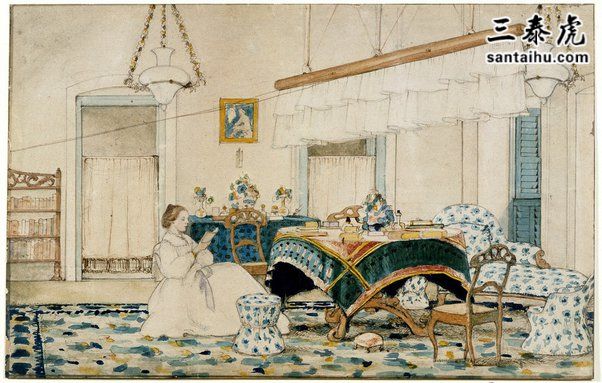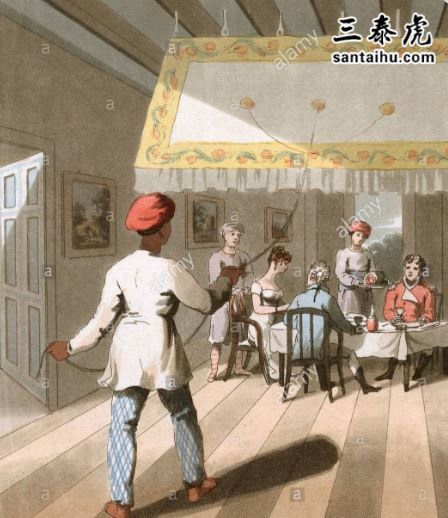When there was no electricity in India, how did British officers live in the scorching heat of India?
在印度没有电的时候,英国军官是如何忍受印度的酷热?
以下是Quora网友的评价:
Angelica Corvinus
Well they just stay indoors and only go at night or at gloomy day where the sun is not blazing hot. They drink lots of water. Just like how the british survive in arabia and africa, they also can survive in india. Humans can adapt to different enviroment. Our earth is not venus.
嗯,他们就呆在室内,只在晚上或阴天太阳不是很毒的时候出门。他们会喝很多水。就像英国人能在阿拉伯和非洲的生活一样,他们当然能在印度生活。人类能够适应不同的环境。我们的地球又不是金星。
Konduru Sarma
By using indigenous cooling techniques picked up from the locals and liberally using the labour of the locals. They were living in sprawling bungalows surrounded by acres of free space and lot of trees, not in the urban multi-story match boxes. They also developed some hill stations to which they used to retire every summer.
英国人会使用当地人的制冷技术,还会大量使用当地劳动力。他们住在大平房里,周围有大片的空地和树木,比市区的多层公寓楼凉快。他们还建了一些山中避暑别墅,每年夏天他们都会去那里度假。
RV
Well, yes india has scorching heat but only in the central plains region, the deccan plateau and coastal areas have pleasant weather all year long, and the Northeast and North are predominantly cool areas often having snowfalls and ice covers in winter season. And for the Britishers dwelling in the central plains, they move to the hill stations when the summer comes to escape the scorchinh heats, they have two capitals based on seasons, the summer capital which is shimla and the winter capital which is new delhi.
好吧,是的,印度是很炎热,但只有中部平原地区比较热,德干高原和沿海地区的气候全年宜人,东北部和北部地区气候凉爽,冬季经常下雪,银装素裹。对于居住在中部平原的英国人来说,每当夏季来临,他们就会到山间别墅避暑,他们有两个季节性首都,夏季的首都在西姆拉,冬季的首都在新德里。
Krishna Kumar Subramanian
First, the British had an EMPIRE.
The EMPIRE was not just India. It stretched across the globe, including ALL equatorial desperately hot regions, deserts and all.
Most did not have electricity.
So the British grin and bore it, like everyone else.
首先,英国是一个帝国。
帝国就不是只有印度了,帝国横跨全球,涵盖了赤道极端炎热的地区、沙漠等等。
大多数地区都没有通电。
因此,英国人和其他人一样,只能忍着。
Railway carriages had cooling arrangements from the 1890s:
19世纪90年代开始,火车车厢就有了制冷装置:
A contrivance for cooling railway carriages is described by Indian Engineering, which consists of a small tank at both ends of the carriage, which receive their supply from the main tank above, which holds water for the passengers' use. From these tanks are conveyed drop troughs, which work automatically, canting over greatly when full of water, and perfectly saturating kus-kus tatties that are suspended across an open trap-door, which is let down at the fore end of the carriage in whichever direction the train a travelling. This keeps up a constant supply of cool air. Added to the cooler is the centre revolving punkah, which is a round light rod fitted with four stiff fans, but not so stiff as to hurt if one's head happens to come in contact. When the train moves the punkah goess round and round, and its revolutions can be moderated by loosening or tightening the check chain.
—English Mechanics and the World of Science, Volume 57
印度工程公司介绍过一种火车车厢的制冷装置,车厢两头各设一个小水箱,从位于车顶、为乘客供水的主水箱中进水。这些水箱有自动出水的水槽,装满水的时候,水槽会倾斜,把岩兰草垫浸透,这些岩兰草垫悬挂在一个敞开的活板门上,不管火车向哪个方向行驶,就把车厢前端的活板门放下。这就保证了凉爽空气的持续供应。除了冷却器之外,中间还有会旋转的蒲葵扇,蒲葵扇是装有四个硬扇叶的圆盘,但也没有硬到让人不小心碰到头就会受伤的地步。当火车行驶时,蒲葵扇就不停转动,它的转速可以通过松开或拧紧链条来调节。
—《英格兰机械与科学世界》,第57卷
In addition, at some homes, the Brits had punkahs (fans). Punkah, in the Orient, was a large, broad fan, swung from the ceiling, and worked by an attendant, to cool a room.
Punkah boys were employed to drive fans to cool the air in residences of the well-to-do.
In India the weather is so hot and oppressive that the members of the white race living there must be almost continuously fanned when at rest, to live in any degree of comfort. The fans are huge contrivances called punkahs, and the servants who swing them to and fro over the white sahibs or memsahibs are called punkah-wallas.
—The Raj
此外,有些英国家庭有蒲葵扇。东方的蒲葵扇是悬挂于天花板上的很大很宽的扇子,仆人们摇动扇叶为房间降温。
有钱人家会雇摇扇工来摇风扇,给房间降温。
在印度,天气十分闷热,居住于此的白人几乎必须不停摇扇才能觉得舒服。这种扇子是一种大型装置,叫做蒲葵扇,给白人先生和白人太太摇扇的仆人被称为摇扇工。
—拉杰
These punkahs were operated by punkah boys.
这些蒲葵扇是由摇扇工来操作的。


By 1895, there are over 120 patents for punkah pullers, and yet none had come into general use in India.
By 1939, some mechanization had come in:
Some of the punkah fans of Hindus and Mohammedans in India have been supplanted by more modern methods of weather making. weather-controlling equipment has been carried on the backs of elephants…
—The Raj
到1895年,已经出现了超过120项蒲葵扇拉手的专利,但在印度都没有得到推广。
到1939年,出现了机械化:
在印度,一些印度教徒和ysl教徒的蒲葵扇已经被更现代的调温工具所取代。温度控制设备被大象驮在背上。
—拉杰
Ordinarily the machine is operated by an electric motor but no current being available, the motor power is furnished by coolies.
The machine was set up to make ice for drinking water and for table purposes in a hot climate.
The machine is the result of the studies and experiments of the Abbe Marcel Audiffren, a French scientist.
通常机器是由电动机驱动的,但印度没有电,就由苦力来提供动力。
这台机器是为了在炎热的气候下制出供饮用水和餐桌使用的冰。
这台机器是法国科学家阿贝·马塞尔·奥迪夫伦研究和实验的结果。
Some have been running ever since they were installed, over five years 'ago, without repairs or recharging with the refrigerating chemical, which in this case is sulphur dioxde.
The machine operates on the compression system and consists of two globes joined by a hollow shaft which carries on its extension a pulley or crank. Its external appearance is that of a dumb bell. It is simple in operation as there are no joints, valves, gauges or stuffing boxes. It is only necessary to place the machine in its bearings, fill the condenser and refrigerator tanks with water and apply the power in order to have at will within a few minutes, cooled water
其中一些自5年前安装以来一直正常运转,没有维修过,也没有再加填冷冻化学物质(在这种情况下是二氧化硫)。
该机器使用了压缩系统,由两个由空心轴连接的球体组成,空心轴通过滑轮或曲柄延伸。它的外观是一个哑铃的造型,操作简单,没有接头、阀门、压力表或填料盒,只需要将机器放置在轴承上,将冷凝器和冰箱水箱注满水并接通电源,即可在几分钟内获得冰水了。

Charles Hiikie
Poor Question.
a) British “Officers” avoided the “scorching heat”. No fear.
b) How did any Indian live before electricity? Maybe you should ask “why are modern Indians living in such an inappropriate way - in thin concrete towers, dependant on electricity?”
这个问题着实可笑。
a)英国“军官”会“避暑”。没啥好怕的。
b)没有电之前印度人是怎么生活的?也许你应该这样问:“为什么现代印度人的生活方式这么奇怪—住在细细高高的混凝土塔里,离了电就没法生活了?”
Charles Hiikie's answer to How did British soldiers cope with the heat in India? Covers the answer for the common soldier and makes reference to the ease of life for the wealthy.
To elaborate briefly; you live in the Indian Way (ie. your schedule and routine) and use the sweat capital of others; ie. Definition of THERMANTIDOTE, Icepits, manually drawn fans and servants to provide all routine cleaning, household work, etc.
对英国士兵如何克服印度高温天气的问题,查尔斯·希基是这么回答的(他提到了普通士兵,也提及了富人的安逸生活)。
简单说的话,就是你可以用印度人的方式生活(比如你的日程安排和日常工作),使用别人的汗水。冷风扇,冰管,手动风扇,仆人负责所有日常清洁和家务工作等。
For transport? Horse, carriage, get carried in a Palanquin or pulled in a rickshaw. how do you move? do you walk?
Then - as now - the rich use the poor to live well. “Officers” used those resources.
至于交通?马、马车、轿子或黄包车等等。你怎么出门?走路吗?
当时就和现在一样,富人利用穷人来过好日子。“官大人们”会使用各种资源。
To understand life in India at the dawn of British ascendancy then read Fanny Parks - published 1850 - to know about life of Indians -rich and poor - before the horrors and trauma of 1857. It’s freely available and written from a very open minded, intelligent point of view from the middle class - exploring the woman’s perspective in particular.
要了解英国统治初期印度人的生活,请阅读1850年出版的《范妮·帕克斯》,了解1857年印度人的生活—无论贫富。此书是从一个非常开放的思想,从中产阶级的智慧的角度—尤其是探索女性的观点—来撰写的。
Arun Sabnis
They all lived in palatial houses where they had servants to pull strings to move the heavy curtains hanging from the ceiling.The windows of the house were covered with curtains of khus weeds which were watered by servants from time to time to keep temperature inside the house as cool as possible.
Besides they shifted residence to hill stations from time to time.
他们都住在富丽堂皇的房子里,有仆人拉绳子摇动挂在天花板上的厚重的布帘。房子的窗户上挂着岩兰草编的草帘,仆人们不时地给草帘洒水,让房子里的温度尽可能凉爽。
另外,他们还会时不时去山间别墅小住。
George Rumbaugh
I wouldn’t have been so concerned for the British Officers. Do you (the OP) not realize there were many, many more lower ranking enlisted volunteers and conscripts in the British Army that also had to put up with the heat? I know they suffered worse conditions in the field and garrison.
To answer your question… From my experiences in Thailand, which wouldn’t even hold a candle to what the British experienced back in the day, you drink lots of water and, over time, get somewhat used to the heat. You don’t have any other choice.
我才不会操心英国军官呢。难道你没有意识到英国军队中还有很多很多低级别的志愿军和征募军不也得忍受高温吗?我知道的,他们在战场和边境的情况更糟。
针对你的问题,以我在泰国的经历来看,都无法与英国人当年的境况相提并论,你得喝很多水,然后就会慢慢习惯当地的炎热了。别无他选。
Bob Brown
I'm baffled at how this question hasn't sparked outrage. Was the temperature somehow cooler for the indigenous people? Were the Enlisted British troops given cooling pills? Why such a question about such a specific group, in a specific region, at a specific time? Why not just “the people” of India? Or Africa? Or the cold of Siberia? Or North Korea?
Maybe I'm seeing something that others are not, but this question strikes me as racist, elitist, and/or possibly a setup for a predetermined answer.
It just seems odd to me.
我很疑惑,为什么这个问题没有引发众怒。难道对土著居民来说,气温有比较低吗?被征募的英国士兵有领到清凉片?为什么要在特定的时间、特定的地区、针对特定的群体提出这样的问题呢?为什么问题问的不只是印度“人民”?或非洲“人民”?还是西伯利亚“人民”或者朝鲜“人民”?
也许我看到了一些其他人没有看到的东西,但这个问题给我的印象是种族主义、精英主义和/或可能是一个预设了答案的引子。
我只是觉得很奇怪。
R Claire Mitchell
They had punkah wallahs of course. The natives making themselves useful making their white masters comfortable by operating a manual ceiling fan for hours on end.
当然了,他们有摇扇工嘛。当地人为了让自己显得有用,能让白人主人们舒服,他们可以连续几个小时拉动吊扇。
Ananth S
They did sweat a lot, what else did they want? to oppress a nation, loot and plunder it and also have an AC?
Jokes aside, they did have traditional fans. the first fans came to India before the East india company held territories for ransom.
他们确实也会出很多汗,不然呢,他们还想什么呢?他们欺压一个国家,掠夺这个国家,难道还想吹空调?
撇开玩笑不谈,他们确实有传统的扇子。在东印度公司开始挟持印度之前,印度就有扇子了。
A.Prem
Many British officals buildings had ‘PUNKAH’. These are hand driven fans made of palymra, bamboo and fabric. These fans hang from the ceiling and are hand operated by coolies called ‘Punkahwala’. Sometimes for want of privacy , the strings attached to the fans are outside of the room and the Punkahwal would operate it sitting in the porch.
Most British buildings in India are built on Indo-Saracenic style. The high roofs, large windows and limestone walls provide a natural cooling effect. Even today you wouldn’t sweat inside such building.
许多英国政府大楼都有“蒲葵扇”。这是用岩兰草、竹子和织物制成的手摇扇。这些吊扇悬挂在天花板上,由摇扇工摇动。有些时候如果想要隐私,会把摇扇绳放在房间外面,摇扇工坐在门廊上摇扇。
印度的大多数英国建筑都是按照印度-撒拉逊风格建造的。高屋顶、大窗户和石灰岩墙壁都提供了天然的降温效果。时至今日,你在这样的建筑里也不会出汗。

 (VIP)6次入常申请被五常轮流否决,印
(VIP)6次入常申请被五常轮流否决,印 (VIP)莫迪接受英国记者的采访,对方
(VIP)莫迪接受英国记者的采访,对方 (VIP)印媒:缅甸危机使印度陷入困境,
(VIP)印媒:缅甸危机使印度陷入困境, 谁掠夺印度最多,莫卧儿王朝、英国人
谁掠夺印度最多,莫卧儿王朝、英国人 如果中国想报复英国的鸦片战争,在没
如果中国想报复英国的鸦片战争,在没 震惊印度,卡塔尔以间谍罪判处8名印
震惊印度,卡塔尔以间谍罪判处8名印 (VIP)印媒:这几天北京遍地是总统,俄
(VIP)印媒:这几天北京遍地是总统,俄 英国是如何用这么少的人口征服半个
英国是如何用这么少的人口征服半个